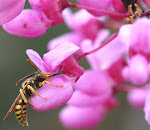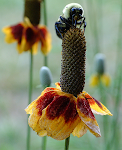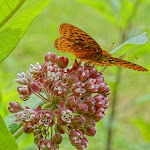Wednesday, July 1, 2009
Her Boadiceous Majesty Elizabeth II
For the sake of lineal clarity (I am making up all kinds of words today), we are keeping the names of each queen consistent (Elizabeth and Kathryn) but adding qualifiers (like I and II which are boring but useful) and in this case: Boadicea, becoz my girl had to battle 4 rivals in a truly bodacious fashion). Get it?
However (she said ominously), in neighboring Kathryn's hive I found two swarm cells! ARRGH! Kathryn has been powering along, raised a ton of brood, and packing away a lot of honey. I have 5 hive bodies on now which is a towering inferno of bees; my chin is level with the top box when I take off the roof.
So as I said, I checked everyone the day before leaving on vacation and there they were: swarm cells. darnitdarnitdarnit. I scraped off one and then stopped and thought: what the heck? So they swarm. This is a powerful hive, there is a lot of brood waiting and honey stored up, let them go. My efforts last time didn't do anything but make me queenless for a while, so ok then: build up the neighborhood bee population.
If I hadn't been leaving for vacation I would have pulled out the frames with queen cells on them and out them in their own hive box and started a new hive....just for fun. Next time.
When I get home I expect a quieter beeyard which will be a little sad but: go Kathryn !
Tuesday, April 14, 2009
We have Larvae!

We have larvae! So exciting to check the hives on Sunday and to discover I am the proud parent of hundreds of little embryonic bees. My queens are doing a great job - both Elizabeth I and Kathryn the Great are filling up combs.
In the picture above (by Scott Camazine/ Science Photo Library) you can see little curled up larval baby bees in their cells. Next to them are "capped brood" cells colored sort of tan. The latter are in the final metamorphosis phase before hatching as full grown, fuzzy striped bees.
Bees go through 4 phases: egg, larva, pupa and adult. Development from egg to new worker typically takes two to three weeks. Great book on this: Tales From the Hive.

Egg
The eggs are described as having an appearance similar to sausage-shaped poppy seeds - except that they are white and standing on one end. They are really really hard to see. One of my beekeeping teachers said "don't worry about it - if you see larvae next week you'll know everything's ok." He was right. Hatching takes place three days after egg laying.
Larva
The larval stage lasts eight to nine days. Upon hatching, the larva resembles a small, white, curved, segmented worm lacking legs and eyes. For the first two days, all larvae are fed a diet of royal jelly. Beginning the third day, worker larvae are fed honey, pollen and water, while the larvae destined to become queens continue to receive royal jelly throughout their larval lives. Regardless of whether the larva is male or female, it molts five times during its larval stage.
| |
Care of the larvae is constant. Each larva receives an estimated 10,000 meals during this stage. The nurse bees do all this feeding - they get water from the foraging worker bees and pollen that was stored in the comb around the brood cells. The bees are all about raising babies.
Larval stage durations vary:
5.5 days for queens (fertile females),
6 days for workers (sterile females), and
6.5 days for drones (fertile males) (Jean-Prost, 1994).
Pupa
The pupal stage is a stage of massive reorganization of tissues. Organs undergo a complete reorganization, while body changes from the wormlike larval body shape to the adult body shape with three distinct body regions. Pupation periods vary: queens require up to 7.5 days, drones require14.5 days, while workers require 12 days.
I can't wait to see a bee hatch!
 Queen and worker pupae. Note the larger size of the queen pupa. Photo by Zach Huang. Queen and worker pupae. Note the larger size of the queen pupa. Photo by Zach Huang. |
Tuesday, April 7, 2009
Making Baby bees


Join your local Beekeepers' Association. Not only do you get to spend time with people similarly obsessed, but you learn a lot from more experienced beekeepers. I went to the Central Virginia Beekeepers' Assn meeting the other night and learned that in a new hive like I have, sometimes the earnest little darlings can be too quick to store up food and can box in the queen with stored sugar syrup and pollen. And the queen needs her elbow room.
Actually she needs room for the nursery. Her job is to lay eggs - up to 1,000 per day - to populate the hive with workers. Bees live about 6 weeks in the spring and summer (longer in winter when they are dormant). So we need new bees to replenish the ranks of my recently hived bees fast.
One of my hives, Queen Elizabeth's, somehow got most of the bees from the two packages I installed. Her royal neighbor, Kathryn the Great, is not doing so great. Fewer bees, less comb drawn out, and less action overall. But Elizabeth's bees went to town that first week, filled in their frames with new wax comb and packed it with syrup and pollen. This was lovely but crowded; I added a second story because I felt it looked to packed in there and lo I was instinctively correct! My more experienced beekeeping friends said too much sugar saved and too little comb means not enough baby bees.
But I am worried about Kathryn hive - I emailed my beekeeping mentor who is experienced and amazingly generous with her time - and asked her to come look. I offered to feed her or ply her wine but she is so gracious she ignored that part of the invitation. We'll see what she recommends.
Meanwhile I continue to feed the girls sugar syrup until the main nectar flow starts which should be in a couple weeks. Watching them come in laden with brilliant pollen and seeing it all laid out like a mosaic in the combs is a lovely thing.




